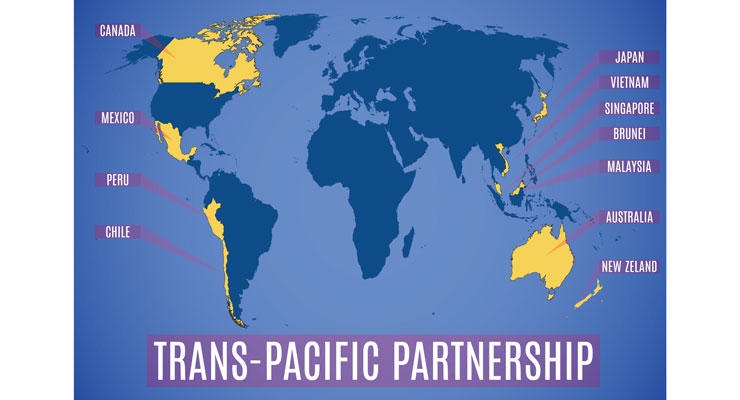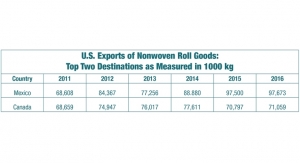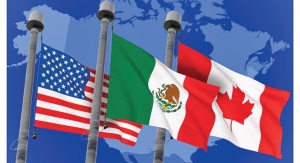Peter G. Mayberry, Contributing Editor03.02.18
As widely noted, The Trans-Pacific Partnership (TPP) negotiations – now currently known as the Comprehensive and Progressive Agreement for Trans-Pacific Partnership (CPTPP) or TPP 2.0 – is an international free trade agreement that’s currently being negotiated with the Pacific Rim nations of Australia, Brunei, Canada, Chile, Japan, Malaysia, Mexico, New Zealand, Peru, Singapore and Vietnam.
While these negotiations are not uniquely impactful to the nonwovens industry per se, they are important to global economic issues overall and, as such, should be carefully studied – especially by U.S. manufacturers.
TPP negotiations began as an expansion of the Trans-Pacific Strategic Economic Partnership Agreement (TPSEP) that was signed by Brunei, Chile, New Zealand and Singapore in 2005. Beginning in 2008, Australia, Canada, Japan, Malaysia, Mexico, Peru, the United States, and Vietnam joined the talks, which brought the total number of countries participating in the negotiations to 12 as of early 2017.
But the TPP was widely derided during the U.S. Presidential elections in 2016 with all three major candidates – Donald Trump, Hillary Clinton and Bernie Sanders disparaging the deal. Support for ratification of a finished treaty in the U.S. Congress, a requirement, was also believed to be shaky at best.
In the end, President Trump unilaterally removed the U.S. from TPP negotiations through a Presidential Memorandum signed January 23, 2017, just two days after his inauguration.
All 11 other TPP countries agreed to revive the deal in May 2017, however, without U.S. participation, and “partial agreement” on a final Agreement framework was reportedly reached by these nations on November 11, 2017, at a meeting in Vietnam.
Now word comes that the U.K. is interested in signing on to the accord as a post-Brexit move, and British officials are eyeing the possibilities. Considering that the U.K. is not a Pacific Rim nation, however, and doesn’t offer a particularly large market for other TPP participants, its chances of being invited to join the pact are considered doubtful.
At Issue
As reported, the original TPP contained measures to lower or eliminate tariff and non-tariff barriers to trade among participating countries while also establishing an investor-state dispute settlement (ISDS) mechanism. And while the U.S. International Trade Commission (ITC), the World Bank, and others determined that TPP would lead to net positive economic outcomes for all signatories, if ratified, it is unclear whether TPP 2.0 would be particularly beneficial without U.S. participation.
Instead, the Office of the U.S. Trade Representative (USTR) most recently issued notice that Cecilia Malmström, European Commissioner for Trade; Hiroshige Seko, Minister of Economy, Trade, and Industry for Japan; and USTR Ambassador Robert E. Lighthizer reached a separate agreement during a meeting in Buenos Aires, Argentina, on December 12, 2017 (see “Capitol Comments,” January 2018). The trilateral agreement is intended “to strengthen our commitment to ensure a global level playing field.”
More specifically, the trilateral agreement appears to point toward China by noting a shared view between the U.S., the European eunion and Japan that “…severe excess capacity in key sectors exacerbated by government-financed and supported capacity expansion, unfair competitive conditions caused by large market-distorting subsidies and state owned enterprises, forced technology transfer, and local content requirements and preferences are concerns for the proper functioning of international trade, the creation of innovative technologies and the sustainable growth of the global economy.”
To address these concerns, the three parties “…agreed to enhance trilateral cooperation in the WTO and in other forums, as appropriate, to eliminate these and other unfair market distorting and protectionist practices by third countries.”
One interesting thing about this joint statement is that it shows at least partial U.S. reliance on the World Trade Organization (WTO) mere months after the Trump administration labeled the body “out of focus” and just weeks before Canada launched a wide-ranging trade dispute in the WTO against the United States, challenging U.S. use of anti-dumping and anti-subsidy duties.
Indeed, the South China Morning Post reports that the Canadian WTO complaint appears to be “…mounting a case on behalf of the rest of the world, since it cited almost 200 examples of alleged U.S. wrongdoing, almost all of them concerning other trading partners, such as China, India, Brazil and the European Union.”
According to SCMP, the 32-page complaint focuses on “technical details” of U.S. trade rules, ranging from “U.S. treatment of export controls to the use of retroactive duties and split decisions by the six-member U.S. International Trade Commission.”
Against this backdrop, Japan Today reports that countries negotiating TPP 2.0 are making progress but, “This is a difficult process, not least because, for many participants, the primary attraction was guaranteed preferential access to the massive U.S. market, a benefit that prompted agreement with many controversial provisions in the original. Indeed, estimates suggest that the regional economic gains will be far smaller for participants in a diminished TPP.”
The publication further notes that “even bigger questions loom” for TPP 2.0 finalization including possible softening of intellectual property rights; efforts to add a new chapter on e-commerce and data privacy; and whether the original schedule of tariff cuts should be renegotiated.
Privately, according to the publication, “many member-nations hold out hope that the U.S. eventually will have a change of heart and join the agreement, meaning that it will not be revised radically from its existing provisions. Nonetheless, even a modified agreement bears promise for improving trade relations and boosting growth in the region, especially if additional countries, such as South Korea, choose to join in the near future.”
The article concludes, “Absent the U.S., China becomes the essential market and source of dynamism in the region. Countries naturally are turning their eyes toward Beijing for leadership. The future of Asia-Pacific integration hangs delicately in the balance.” The New York Times, in fact, reports that China is in discussion with 16 Asia-Pacific countries – including Japan, India, and South Korea – for a sweeping free trade pact across the region.
Adding to the confusion, Canada has raised concerns over certain TPP 2.0 provisions. As reported by CNBC, Canadian Prime Minister Justin Trudeau has declared that “more work is needed on the pact…amid concerns about what it would mean for Canadian jobs.” Similarly, there is growing pushback in Japan over a raft of agricultural issues included in TPP 2.0.
Nevertheless, Japanese Prime Minister Shinzo Abe – who has been leading TPP 2.0 negotiations since the U.S. pulled out – predicts a final deal could be signed by remaining nations as early as February or March 2018.
In terms of timeframe, negotiators from the 11 nations were slated to meet in Japan in late January 2018, to work out “unresolved details” of the pact. If these “details” can successfully be resolved at the January meeting, the next step would be translating the Agreement into members’ various languages followed by legal review.
After that, the final pact would have to be ratified by each participating country. This could become difficult and time consuming – especially if legislatures in one or more of these countries push back against the negotiated deal. Such pushback is entirely possible considering TPP and TPP 2.0 negotiations were held in absolute secrecy and lawmakers typically won’t see the Agreement’s complete and final language until shortly before they’re asked to vote on it.
As it stands, TPP 2.0 will go into effect if at least six countries ratify the final accord, so it would be possible to ignore Canadian concerns. But if other countries heed warnings from the U.S. and Canada, finalization and implementation of the Agreement may indeed be difficult. As the Nikkei Asian Review notes, “Canada, with its vague insistence on language allowing it to better protect Canadian culture remains a major question mark” regarding success or failure of TPP 2.0.
Editors’ Note
After this article went to press, the 11 Pacific Rim countries involved in TPP 2.0 negotiations finalized a deal on January 24, 2018, that is being characterized as far less ambitious than what was on the table when the U.S. backed away from negotiations. According to Forbes, “The CPTPP, signed exactly a year and a day after Trump tanked the original TPP, will strip out most of the provisions that made the TPP something more than an old-fashioned trade agreement.” Forbes further notes that the 11 TPP partners “...were only able to come to a symbolic agreement on the CPTPP by eliminating a raft of TPP provisions (20 in all), including those on: investor-state dispute settlement (ISDS); digital intellectual property protection; copyright extensions and harmonization; patent extensions and harmonization; liberalization of the pharmaceutical sector; liberalization of postal services; opening of telecom markets; and government procurement.” What’s left, according to the magazine, is an agreement that still must be ratified by each of the negotiating countries, and is pretty much limited to abolishing “all tariffs on seafood, wine, sheep meat, cotton wool, and manufactured goods” among these 11 countries.
While these negotiations are not uniquely impactful to the nonwovens industry per se, they are important to global economic issues overall and, as such, should be carefully studied – especially by U.S. manufacturers.
TPP negotiations began as an expansion of the Trans-Pacific Strategic Economic Partnership Agreement (TPSEP) that was signed by Brunei, Chile, New Zealand and Singapore in 2005. Beginning in 2008, Australia, Canada, Japan, Malaysia, Mexico, Peru, the United States, and Vietnam joined the talks, which brought the total number of countries participating in the negotiations to 12 as of early 2017.
But the TPP was widely derided during the U.S. Presidential elections in 2016 with all three major candidates – Donald Trump, Hillary Clinton and Bernie Sanders disparaging the deal. Support for ratification of a finished treaty in the U.S. Congress, a requirement, was also believed to be shaky at best.
In the end, President Trump unilaterally removed the U.S. from TPP negotiations through a Presidential Memorandum signed January 23, 2017, just two days after his inauguration.
All 11 other TPP countries agreed to revive the deal in May 2017, however, without U.S. participation, and “partial agreement” on a final Agreement framework was reportedly reached by these nations on November 11, 2017, at a meeting in Vietnam.
Now word comes that the U.K. is interested in signing on to the accord as a post-Brexit move, and British officials are eyeing the possibilities. Considering that the U.K. is not a Pacific Rim nation, however, and doesn’t offer a particularly large market for other TPP participants, its chances of being invited to join the pact are considered doubtful.
At Issue
As reported, the original TPP contained measures to lower or eliminate tariff and non-tariff barriers to trade among participating countries while also establishing an investor-state dispute settlement (ISDS) mechanism. And while the U.S. International Trade Commission (ITC), the World Bank, and others determined that TPP would lead to net positive economic outcomes for all signatories, if ratified, it is unclear whether TPP 2.0 would be particularly beneficial without U.S. participation.
Instead, the Office of the U.S. Trade Representative (USTR) most recently issued notice that Cecilia Malmström, European Commissioner for Trade; Hiroshige Seko, Minister of Economy, Trade, and Industry for Japan; and USTR Ambassador Robert E. Lighthizer reached a separate agreement during a meeting in Buenos Aires, Argentina, on December 12, 2017 (see “Capitol Comments,” January 2018). The trilateral agreement is intended “to strengthen our commitment to ensure a global level playing field.”
More specifically, the trilateral agreement appears to point toward China by noting a shared view between the U.S., the European eunion and Japan that “…severe excess capacity in key sectors exacerbated by government-financed and supported capacity expansion, unfair competitive conditions caused by large market-distorting subsidies and state owned enterprises, forced technology transfer, and local content requirements and preferences are concerns for the proper functioning of international trade, the creation of innovative technologies and the sustainable growth of the global economy.”
To address these concerns, the three parties “…agreed to enhance trilateral cooperation in the WTO and in other forums, as appropriate, to eliminate these and other unfair market distorting and protectionist practices by third countries.”
One interesting thing about this joint statement is that it shows at least partial U.S. reliance on the World Trade Organization (WTO) mere months after the Trump administration labeled the body “out of focus” and just weeks before Canada launched a wide-ranging trade dispute in the WTO against the United States, challenging U.S. use of anti-dumping and anti-subsidy duties.
Indeed, the South China Morning Post reports that the Canadian WTO complaint appears to be “…mounting a case on behalf of the rest of the world, since it cited almost 200 examples of alleged U.S. wrongdoing, almost all of them concerning other trading partners, such as China, India, Brazil and the European Union.”
According to SCMP, the 32-page complaint focuses on “technical details” of U.S. trade rules, ranging from “U.S. treatment of export controls to the use of retroactive duties and split decisions by the six-member U.S. International Trade Commission.”
Against this backdrop, Japan Today reports that countries negotiating TPP 2.0 are making progress but, “This is a difficult process, not least because, for many participants, the primary attraction was guaranteed preferential access to the massive U.S. market, a benefit that prompted agreement with many controversial provisions in the original. Indeed, estimates suggest that the regional economic gains will be far smaller for participants in a diminished TPP.”
The publication further notes that “even bigger questions loom” for TPP 2.0 finalization including possible softening of intellectual property rights; efforts to add a new chapter on e-commerce and data privacy; and whether the original schedule of tariff cuts should be renegotiated.
Privately, according to the publication, “many member-nations hold out hope that the U.S. eventually will have a change of heart and join the agreement, meaning that it will not be revised radically from its existing provisions. Nonetheless, even a modified agreement bears promise for improving trade relations and boosting growth in the region, especially if additional countries, such as South Korea, choose to join in the near future.”
The article concludes, “Absent the U.S., China becomes the essential market and source of dynamism in the region. Countries naturally are turning their eyes toward Beijing for leadership. The future of Asia-Pacific integration hangs delicately in the balance.” The New York Times, in fact, reports that China is in discussion with 16 Asia-Pacific countries – including Japan, India, and South Korea – for a sweeping free trade pact across the region.
Adding to the confusion, Canada has raised concerns over certain TPP 2.0 provisions. As reported by CNBC, Canadian Prime Minister Justin Trudeau has declared that “more work is needed on the pact…amid concerns about what it would mean for Canadian jobs.” Similarly, there is growing pushback in Japan over a raft of agricultural issues included in TPP 2.0.
Nevertheless, Japanese Prime Minister Shinzo Abe – who has been leading TPP 2.0 negotiations since the U.S. pulled out – predicts a final deal could be signed by remaining nations as early as February or March 2018.
In terms of timeframe, negotiators from the 11 nations were slated to meet in Japan in late January 2018, to work out “unresolved details” of the pact. If these “details” can successfully be resolved at the January meeting, the next step would be translating the Agreement into members’ various languages followed by legal review.
After that, the final pact would have to be ratified by each participating country. This could become difficult and time consuming – especially if legislatures in one or more of these countries push back against the negotiated deal. Such pushback is entirely possible considering TPP and TPP 2.0 negotiations were held in absolute secrecy and lawmakers typically won’t see the Agreement’s complete and final language until shortly before they’re asked to vote on it.
As it stands, TPP 2.0 will go into effect if at least six countries ratify the final accord, so it would be possible to ignore Canadian concerns. But if other countries heed warnings from the U.S. and Canada, finalization and implementation of the Agreement may indeed be difficult. As the Nikkei Asian Review notes, “Canada, with its vague insistence on language allowing it to better protect Canadian culture remains a major question mark” regarding success or failure of TPP 2.0.
Editors’ Note
After this article went to press, the 11 Pacific Rim countries involved in TPP 2.0 negotiations finalized a deal on January 24, 2018, that is being characterized as far less ambitious than what was on the table when the U.S. backed away from negotiations. According to Forbes, “The CPTPP, signed exactly a year and a day after Trump tanked the original TPP, will strip out most of the provisions that made the TPP something more than an old-fashioned trade agreement.” Forbes further notes that the 11 TPP partners “...were only able to come to a symbolic agreement on the CPTPP by eliminating a raft of TPP provisions (20 in all), including those on: investor-state dispute settlement (ISDS); digital intellectual property protection; copyright extensions and harmonization; patent extensions and harmonization; liberalization of the pharmaceutical sector; liberalization of postal services; opening of telecom markets; and government procurement.” What’s left, according to the magazine, is an agreement that still must be ratified by each of the negotiating countries, and is pretty much limited to abolishing “all tariffs on seafood, wine, sheep meat, cotton wool, and manufactured goods” among these 11 countries.











